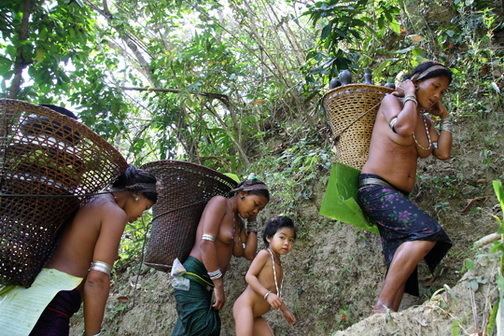ISO 639-3 mro | Native speakers 50,000 (1999–2007) Glottolog mruu1242 | |
 | ||
Language family Sino-TibetanLolo-Burmese?MruicMru Writing system Mru alphabet, Latin alphabet | ||
Mru is a Sino-Tibetan language and one of the recognized languages of Bangladesh. It is spoken by a community of Mros (Mru) inhabiting the Chittagong Hill Tracts of Bangladesh with a population of 22,000 according to the 1991 census, and in Burma. The Mros are the second-largest tribal group in Bandarban District of the Chittagong Hill Tracts. A small group of Mros also live in Rangamati Hill District.
Contents
The Mru language is considered "definitely endangered" by UNESCO in June 2010.
It is one of the Sino-Tibetan languages that are difficult to classify and has marginal affiliations with Burmic. Mru and Meithei in India, Bangladesh, and Burma, would appear close to the Kukish languages. However, although once classified as Kukish, the Mru language is thought to be closer to Lolo-Burmese.
Distribution
The Mros live in forest areas of Lama, Ruma, Alikaram, and Thanchi near Chimbuk Mountain of Bandarban District (Rashel 2009). They also live in Sittwe (Akiab), Rakhine State, Burma.
Subdivisions
There are five major Mro clans (Rashel 2009).
Rashel (2009) also lists another classification scheme which lists ten Mro clans.
Numerals
Rashel (2009:159) lists the following Mro numerals.
- lɔk
- pre
- ʃum
- taːli
- taŋa
- tro
- rinit
- rijat
- tako
- muit
Alphabet
The Mru alphabet is an indigenous, messianic script: In the 1980s Menlay Murang (also known as Manley Mro) created the religion of Khrama (or Crama) and with it a new alphabet for the Mru language.
The Mru (or Mro) alphabet is written from left to right and has its own set of digits. It does not use tone marks.
The Mru language is written using both the Latin and Mru alphabets.
Unicode
The Mru alphabet was added to the Unicode Standard in June, 2014 with the release of version 7.0.
The Unicode block for the Mru alphabet, called Mro, is U+16A40–U+16A6F:
